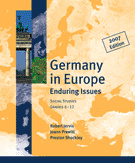Topic 1: Germany’s Changing Position in Europe and the World

Lesson 1
Step #2: Extending and Refining Information
Step #2: Extending and Refining Information
Strategy: Reconstructive Responses
- How does Germany compare to the United States and the rest of Europe in land size, GDP, and relative population?
- What is the significance of the location of Germany?
Activities
Have the students work in four groups. Give each group a resource folder. Use the resources provided to make up the folders:

#1. Country Size by Land Area |  #2. Country Size by Population |
 #3. Country Size by Gross Domestic Product |  #4. Population Statistics on the European States |
Have each group review the information in the resource folder. Assign each group a different transparency to review in depth. Have the group use one of the reconstructive response techniques to elicit clear concise information from the transparency. For example:
- Summary Response – have the group come up with the basic message
of the transparency. Have the students create one or two summary statements
about what the transparency says about Germany in relation to
other nations.
- Precise Response – Briefly state in a paragraph the key information from the transparency with all unnecessary words removed. The result is a factual reinterpretation of the transparency in paragraph form.
- Question Response – Put the main points of the transparency in question format. Have the students create one question that will lead to a discussion of the main points of the transparency.
- Precise Response – Briefly state in a paragraph the key information from the transparency with all unnecessary words removed. The result is a factual reinterpretation of the transparency in paragraph form.
- Geographically, Europe is small compared to other cultural regions of the
world.
- The relative size of Europe in terms of population is increasing, but is still relatively small.
- The economic power of Europe is enormous compared to its land size and population
- Use Why Study Germany to summarize the discussion.
- The relative size of Europe in terms of population is increasing, but is still relatively small.
Why Study Germany?
- Germany is a prime mover in European integration.
- Germany is geographically located in the center of Europe with political, economic, and social windows that open East and West.
- Germany is an industrial giant in Europe and one of the three leading exporting nations in the world.
- Germany can be studied as a model of post World War II reconstruction and a microcosm of “cold war” conflict.
- Germany serves as a model for emerging nations and for Europe.
- Germany has provided a legacy of literary and political thought that has impacted the evolution of Western Civilization.
- Germany is the ancestral home to millions of immigrants to the United States.
- Germany, for many years a “non-immigration” country, now must learn to deal with increasing problems with foreign minorities.
- Germany and the United States have common problems; a comparative analysis can help both nations find appropriate solutions.
- Germany offers a case study in contrast and contradiction – it has freely offered the world its people and its artistic and scientific genius; it has also been at the source of devastating war and unparalleled genocide.

 Printable PDF
Printable PDF